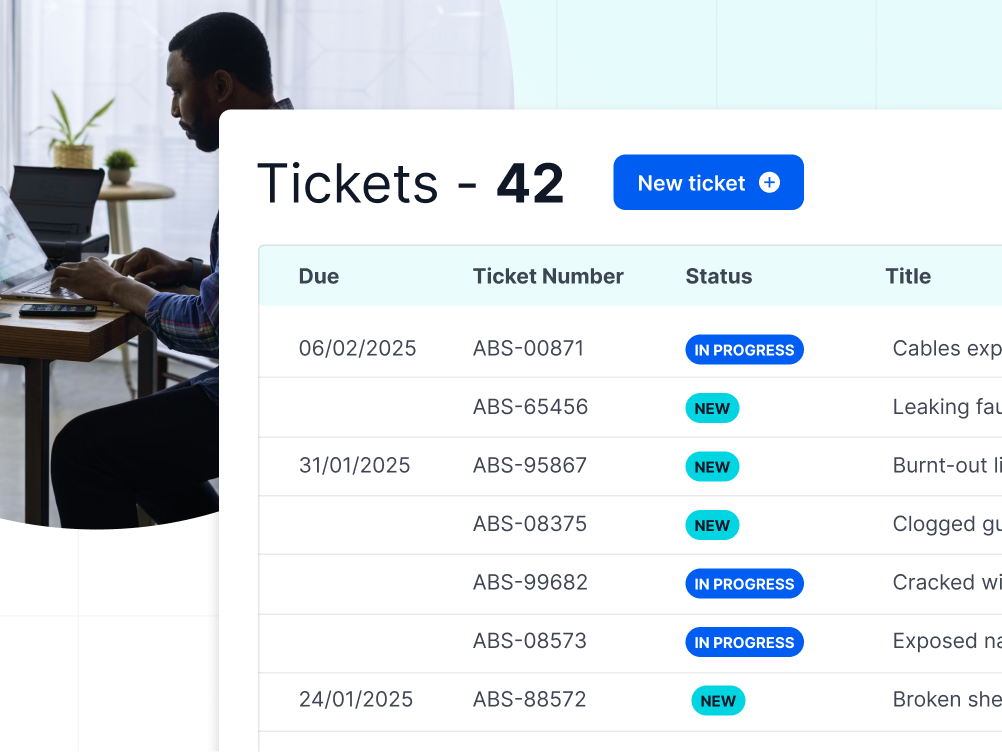NEW FEATURE! 👉 See every planned maintenance task on a single calendar. Book a demo here








Facilities management can be a headache when you don't have the right processes and tools to help you get through the day and ensure your facilities are well maintained and in great condition for staff and any guests or customers.



In this short video we will quickly show you can example of how you can create a reactive ticket within the FaultFixers simple CAFM interface.

An improved facility can only have a positive impact on a business. No matter which industry you work in, be it healthcare, retail, hospitality or education. Improving the processes around your facility maintenance will improve the facility itself and the environment. This improves the experience the staff and users of that environment have.
An improved facility for a hotel can mean charging higher rates, for a school it means a better learning environment for kids. Facility maintenance is the core of great experiences.




We built FaultFixers with simple but powerful features that make your maintenance operations life easier, have a browse through all of our maintenance software features.






Our comprehensive CAFM software is designed to revolutionise the way you handle maintenance tasks, enabling you to automate, organise, and track everything in a single, user-friendly platform.








Common questions about CAFM Software answered.
A CAFM system, or Computer-Aided Facility Management software, is a digital tool that helps businesses manage buildings, assets, and maintenance operations efficiently. It works by integrating real-time data, automation, and reporting tools to streamline facility management tasks such as work order tracking, space optimization, asset maintenance, and compliance reporting. Most CAFM platforms include cloud-based dashboards, mobile accessibility, and IoT integrations, allowing facilities managers to monitor performance, reduce costs, and improve efficiency from a single system.
A CAFM system improves maintenance management by automating preventive and reactive maintenance, reducing downtime and unexpected costs. It optimizes space utilization by ensuring office layouts, meeting rooms, and real estate assets are used effectively. By reducing energy consumption and streamlining operations, businesses can lower costs and increase efficiency. CAFM software also ensures regulatory compliance by helping businesses meet health, safety, and environmental standards. Additionally, it provides real-time data insights, allowing businesses to make informed decisions about asset performance and facility usage.
CAFM, CMMS, and IWMS are all facility management software solutions, but they serve different purposes. A CAFM system focuses on space planning, asset tracking, and maintenance management, making it ideal for real estate, corporate offices, and large facilities. CMMS, or Computerized Maintenance Management System, is primarily used for maintenance scheduling, work orders, and equipment upkeep in industries such as manufacturing, healthcare, and logistics. IWMS, or Integrated Workplace Management System, is a broader platform that includes CAFM functionalities along with lease management, sustainability tracking, and financial planning. Businesses that need comprehensive building and asset management typically choose CAFM, while CMMS is best for maintenance-specific needs and IWMS is suited for enterprise-wide facility management.
Yes, modern CAFM systems can integrate with various business applications to enhance efficiency and data accuracy. Many solutions offer compatibility with ERP software like SAP, Oracle, and Microsoft Dynamics for financial and procurement management. They can also integrate with HR and workforce management tools to assist with staff scheduling and workspace bookings. Smart building systems and IoT devices can connect to CAFM software for real-time monitoring of energy usage, HVAC performance, and security systems. Some CAFM platforms also support integration with BIM (Building Information Modeling) for improved building lifecycle planning and asset tracking. These integrations create a fully connected facility management ecosystem, ensuring smooth cross-department collaboration.
Choosing the right CAFM software depends on factors such as business size, facility complexity, and key operational needs. Cloud-based CAFM systems offer greater flexibility and remote access, while on-premise solutions may be preferred for organizations requiring full data control. Essential features to consider include asset tracking, work order automation, compliance reporting, and mobile accessibility for on-the-go facility management. User-friendliness is also crucial, as an intuitive interface makes adoption easier for teams. Businesses should check integration capabilities with existing ERP, HR, and IoT systems to ensure seamless connectivity. To make an informed decision, it is recommended to request demos, compare pricing models, and review customer testimonials to find a solution that aligns with long-term facility management goals.